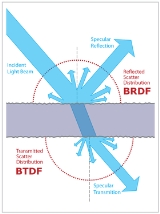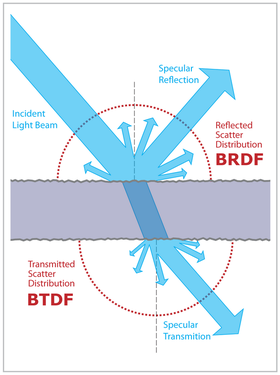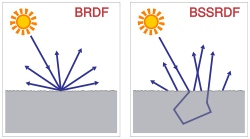
Bidirectional scattering distribution function
Encyclopedia
The definition of the BSDF (Bidirectional scattering distribution function) is not well standardized. The term was probably introduced in 1991 by Paul Heckbert. Most often it is used to name the general mathematical function which describes the way in which the light is scattered by a surface. However in practice this phenomenon is usually split into the reflected and transmitted components, which are then treated separately as BRDF (Bidirectional reflectance distribution function
) and BTDF (Bidirectional transmittance distribution function).


Bidirectional reflectance distribution function
The bidirectional reflectance distribution function is a four-dimensional function that defines how light is reflected at an opaque surface...
) and BTDF (Bidirectional transmittance distribution function).

- BSDF is a superset and the generalization of the BRDF and BTDF. The concept behind all BxDF functions could be described as a black box with the inputs being any two angles, one for incoming (incident) ray and the second one for the outgoing (reflected or transmitted) ray at a given point of the surface. The output of this black box is the value defining the ratio between the incoming and the outgoing light energy for the given couple of angles. The content of the black box may be a mathematical formula which more or less accurately tries to model and approximate the actual surface behavior or an algorithm which produces the output based on discrete samples of measured data. This implies that the function is 4 (+1) dimensional (4 values for 2 3D angles + 1 optional for wave length of the light), which means that it cannot be simply represented by 2D and not even by a 3D graph. Each 2D or 3D graph, sometimes seen in the literature, shows only a slice of the function.
- Some tend to use the term BSDF simply as a category name covering the whole family of BxDF functions.
- The term BSDF is sometimes used in a slightly different context, for the function describing the amount of the scatter (not scattered light), scatter being simply a function of the incident light angle. An example to illustrate this context: for perfectly lambertian surface the BSDF(angle)=const. This approach is used for instance to verify the output quality by the manufacturers of the glossy surfaces.
- Another recent usage of the term BSDF can be seen in some 3D packages, when vendors use it as a 'smart' category to encompass the simple well known cg algorithms like Phong, Blinn etc.
Overview of the BxDF functions

- BSDF (Bidirectional scattering distribution function) is the most general function.
- BSSRDF (Bidirectional surface scattering reflectance distribution function or B scattering surface RDF)describes the relation between outgoing radiance and the incident flux, including the phenomena like subsurface scatteringSubsurface scatteringSubsurface scattering is a mechanism of light transport in which light penetrates the surface of a translucent object, is scattered by interacting with the material, and exits the surface at a different point...
(SSS). The BSSRDF describes how light is transported between any two rays that hit a surface. - BRDF (Bidirectional reflectance distribution functionBidirectional reflectance distribution functionThe bidirectional reflectance distribution function is a four-dimensional function that defines how light is reflected at an opaque surface...
) is a simplified BSSRDF, assuming that light enters and leaves at the same point (see the image on the right). - BTDF (Bidirectional transmittance distribution function) is similar to BRDF but for the opposite side of the surface. (see the top image).
See also
- BRDFBidirectional reflectance distribution functionThe bidirectional reflectance distribution function is a four-dimensional function that defines how light is reflected at an opaque surface...
- Subsurface scatteringSubsurface scatteringSubsurface scattering is a mechanism of light transport in which light penetrates the surface of a translucent object, is scattered by interacting with the material, and exits the surface at a different point...
- RadiometryRadiometryIn optics, radiometry is a set of techniques for measuring electromagnetic radiation, including visible light. Radiometric techniques characterize the distribution of the radiation's power in space, as opposed to photometric techniques, which characterize the light's interaction with the human eye...
- Reflectance
- RadianceRadianceRadiance and spectral radiance are radiometric measures that describe the amount of radiation such as light or radiant heat that passes through or is emitted from a particular area, and falls within a given solid angle in a specified direction. They are used to characterize both emission from...
- BTF

